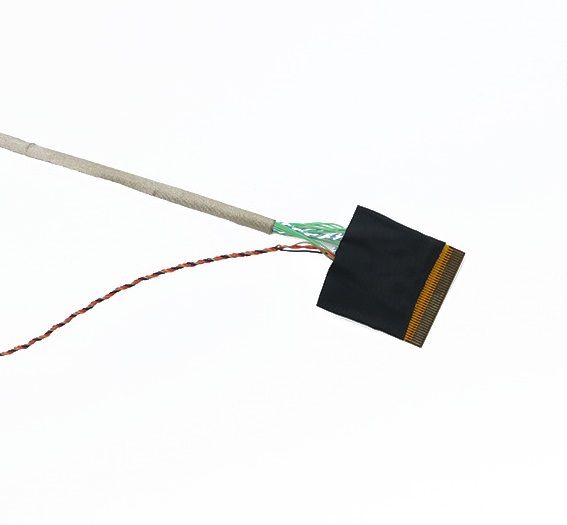How to solve the EDP cable signal interference problem?
Solving the EDP (Embedded DisplayPort) line signal interference problem is a complex task involving many factors. As a kind of high-speed digital signal transmission line, the signal interference of EDP line may lead to the degradation of image quality, abnormal display and even unstable system. The following will discuss in detail the causes of
EDP wire signal interference problems, inspection methods and specific solutions, the content of about 1500 words.
First, the cause of the EDP line signal interference problem
1. Complex electromagnetic environment:
In the modern electronic equipment dense environment, various electromagnetic radiation sources (such as power lines, high-frequency signal lines, wireless devices, etc.) may produce electromagnetic interference, affecting the transmission of EDP signals.
2. Impedance mismatch:
• When the characteristic impedance of the EDP signal line does not match the impedance of the sending or receiving end, it will cause signal reflection, resulting in signal distortion or attenuation.
3. Grounding problem:
• Poor grounding design or poor grounding wire connection may cause ground loop interference and affect the stability of the EDP signal.

4. Wire quality problem:
• The use of unqualified EDP lines, such as excessive line resistance, characteristic impedance parameters do not meet the standard, will lead to signal attenuation or distortion.
5. Poor connection:
• Loose, poor contact, or damaged EDP line connectors may also cause signal interference.
Second, the EDP line signal interference inspection method
1. The display is abnormal:
• When the EDP line is disturbed by the signal, the display may appear image flicker, flower screen, color distortion and other abnormal phenomena.
2. Use testing tools:
• Test tools such as oscilloscopes and signal analyzers can be used to monitor and analyze EDP signals in real time to determine whether the signal quality is affected.
3. Check the wire and connector:
• Carefully inspect the appearance of the EDP wire for damage, aging, or deformation, and connectors for loose, poor contact, or damage.
4. Analyze the electromagnetic environment:
• Evaluate the electromagnetic environment of the EDP line to determine whether there are potential sources of interference, such as high frequency signal lines, wireless devices, etc.
Third, the specific scheme to solve the problem of EDP line signal interference
1. Optimize the electromagnetic environment:
• Try to avoid placing EDP lines near strong electromagnetic sources, such as power cables, high-frequency signal lines, etc.
If it cannot be avoided, shielding measures can be taken, such as the use of metal shielding enclosures or shielding wires to reduce electromagnetic interference.
2. Impedance matching:
• Ensure that the characteristic impedance of the EDP signal line matches the impedance of the sending and receiving ends.
• In PCB design, impedance matching can be achieved by adjusting the width and spacing of signal lines and using terminal resistors.
3. Improve grounding design:
• Adopt good grounding design to ensure that the grounding wire of the EDP signal line is connected reliably and the grounding resistance is small.
• Avoid ground loop interference, try to use a single point grounding method to reduce the impact of ground potential difference on the signal.
4. Choose high quality wire:
• Select a qualified EDP line to ensure that the line resistance is low and the characteristic impedance parameters meet the standard.
• Priority is given to using EDP lines with shielding layers to improve anti-interference capability.
5. Ensure reliable connection:
• Check EDP wire connectors regularly for loose, poor contact or damage, and replace damaged connectors in time.
• When connecting, ensure that the connector is tightly inserted and in good contact to avoid signal interference caused by virtual connection or poor contact.
6. Use anti-jamming components:
• Add elements such as anti-jamming magnetic rings or filter capacitors to the EDP signal lines to suppress high-frequency noise and electromagnetic interference.
• Anti-interference magnetic ring is usually made of ferrite material, which has good high-frequency suppression performance.
7. Upgrade hardware and software:
• If the EDP line signal interference problem persists, it may be necessary to consider upgrading the hardware and software on the sending or receiving end.
New hardware and software versions may have better signal processing capabilities and anti-jamming performance.
8. Professional testing and maintenance:
• Regular use of professional testing tools to test and analyze EDP signals to ensure that signal quality meets requirements.
• If problems are found, repair or replace damaged parts in a timely manner.
Iv. Summary
To solve the problem of EDP line signal interference, it is necessary to consider the electromagnetic environment, impedance matching, grounding design, wire quality, connection reliability and other factors. By optimizing the electromagnetic environment, realizing impedance matching, improving grounding design, selecting high-quality wire, ensuring reliable connection, using anti-interference components, upgrading hardware and software, and conducting professional testing and maintenance, we can effectively reduce the signal interference problem of EDP line and improve the stability and reliability of the display system. In practical applications, the appropriate solution should be flexibly selected according to the specific situation, and the signal quality should be continuously paid attention to and optimized.
